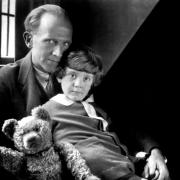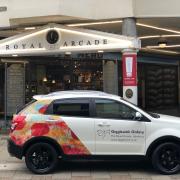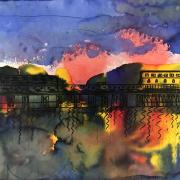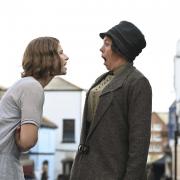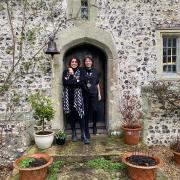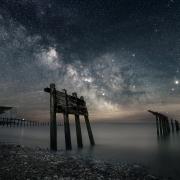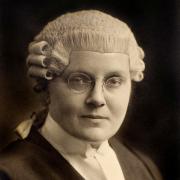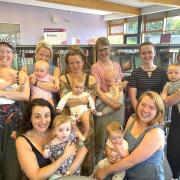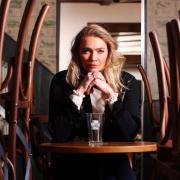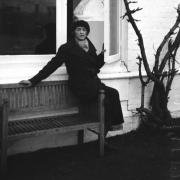Midhurst-based marine photographer Kos Evans goes to great lengths for her art. Angela Wintle found out why
Kos Evans sensed something was wrong as soon as she saw the crew climbing over the side of the boat. Never a good sign when you're strapped 40ft up a mast. She'd been taking pictures in Southampton Water when the crew lost control and realised they were about to capsize.
But ever the professional, and despite the very real prospect that she was about to face a watery grave, Kos kept snapping. "All I could think about was trying to shoot as much of the fall as possible before the mast hit the water," she says. "As I flew through the air, I tried to climb on top of the mast to avoid it hitting me and knocking me unconscious. But when we struck the water, I soon faced other problems - my camera was thrown from my hand and the weight of the mast and sails began dragging me under."
Matters looked very serious indeed until her husband Chris, who had been sailing alongside, managed to grab the back of her jacket collar in the nick of time, while another crew member dived to cut her free. Not for the first time, she'd escaped death by the skin of her teeth. But as a new book, Walking on Water: The Daredevil Acrobatics of a Pioneering Photographer, reveals, Kos will go to almost any lengths for her art. If she isn't leaping between racing yachts in rough weather or dangling out of helicopters on a harness at 100mph, she's climbing 200ft masts or diving deep beneath the surface of the ocean in pursuit of the most dramatic sports imagery.
Kos, short for Koren, has been at the forefront of marine photography for more than 30 years and has covered all the major yachting events - from the Olympics and America's Cup to the Whitbread Round the World and Fastnet races.
But the sea, as the saying goes, can be a cruel mistress. "The biggest challenge is working from a moving platform, shooting a moving subject," she says. "You have to dodge waves and seasickness, not to mention avoiding falling overboard! And water gets into everything, not least your camera gear."
It can also be tough working in a male-dominated environment. "Working as a woman among a large team of serious male athletes can feel quite threatening because their whole focus is on winning and little else. There's little priority or consideration for a photographer, and in the days before sponsorship caught on, my role wasn't highly regarded by the crew."
She learnt this to her cost when she was asked to take a masthead promotional image while working as official photographer for the British America's Cup Campaign in Fremantle, Australia. After waiting all day in soaring temperatures for her moment, she was finally invited on board and hoisted up the masthead. But she'd barely caught her breath before the skipper warned her to hold on, and then the yacht began furiously rolling back and forth as it surfed over huge waves.
"I gripped the mast tightly with my knees, waiting for all hell to let loose as the yacht and its mainsail crashed through a jib," she says. "But a few seconds passed and nothing happened. Then I looked down and saw, to my amazement, that there was absolutely no one on board. I was 80ft up a mast, sailing flat out with no crew, and the shore was fast approaching.
"Then a head suddenly appeared from a hatch. As a prank, the 11-strong crew had shot down below out of sight - just to wind me up. I threatened to kill them when I reached dry land, though the picture of the deserted boat made a crazy image and was later used to promote the campaign."
Kos, now in her 50s, is speaking from the Midhurst home she shares with her husband and daughter, Ocean, nine. They moved from London six years ago when Kos decided that she wanted Ocean to enjoy the rural surroundings she'd enjoyed as a child.
"We came across our house by accident and fell in love with it immediately. We moor our boat at Chichester Harbour and spend a lot of time on the Solent because I love photographing the beautiful inlets, natural harbours and quaint little villages along the Sussex coast," she says.
Kos picked up a camera when she was two, but only decided that boats were her thing when she climbed aboard her first ocean-going yacht with Peter de Savary's America's Cup syndicate in 1982. She quickly acquired a reputation as the danger woman of sports photography and clients began hiring her because she always strove to find an angle that hadn't been attempted before. "Soon, I was shooting F1 circuit powerboats from in the water and had to wear a red flag attached to my back so the drivers could see me bobbing in the lake as they passed by at 100mph," she says.
She took her first trademark masthead shot onboard the British yacht, Victory, in 1982, a feat which hadn't been attempted since the 1800s. "These images ticked every box," she says. "They were cool, unusual and difficult to take. They also required a real head for heights. Not only do I have to negotiate the flagging sails, but numerous metal wires, ropes and spreaders, which usually beat me up. You also need a lot of strength to stop yourself being flung from the mast, which moves on every wave and gust of wind - with ten times the amount of movement on deck.
"On the very large masts, I use a rope tied to the bottom of my climbing harness to stop me heading skyward. It also helps to prevent me being thrown off the mast part way up, which can cause serious head injuries because you fly out, swing round on a 50ft or 100ft pendulum, and then smack back into the mast and rigging at great speed."
In her book, Kos picks out some of the highlights of her rich career - from shadowing American yachting legend Dennis Connor and undertaking a dangerous assignment in war-torn Bosnia to shooting the British Sailing team in the buff for the 1984 LA Olympics.
But perhaps the most exciting commission was filming James Bond, alias Pierce Brosnan, from her boat down the Thames through central London for a high-speed boat chase which later formed the thrilling opening sequence to the Bond film, The World Is Not Enough. "We raced through six simultaneous explosions of water measuring 100ft high and even hit a dock wall at speed, which shortened my boat by several feet," she says. "But flying through the heart of London with machine-gun fire and Brosnan's characteristic voice in my headset made everything worthwhile. I find it surreal watching the movie and hearing the familiar noise of my boat on the big screen." But Kos is well accustomed to working with household names. In 1984, Duran Duran asked her to photograph Simon le Bon's 80ft maxi yacht Drum before he embarked on a Whitbread Round the World race. While shooting her trademark masthead photo, she suggested that le Bon might wish to climb the rigging for a really heroic image. He agreed, even though it was blowing Force 7, and decided to go right to the top of the mast.
"The maxi yacht was heeled right over in the strong wind and Simon courageously let go of the mast to swing out over the water on a massive pendulum. He pretended to walk in mid-air and started to impersonate Superman flying. But the crew decided he was getting a bit cocky, so they released the halyard and he plummeted 50 ft - stopping just inches from the water. It was a heart-stopping moment!"
Kos used to spend up to eight months afloat, but the gruelling schedule began to take its toll. "I covered a lot of events when my daughter was young, but my long absences made her feel quite insecure, so I became choosier about the projects I accepted."
Though she enjoys action photography, Kos has increasingly seen her work as art pieces. "My eyes are always open to the unusual and I love finding an image right under my nose, which no one else has noticed. Marinas are fantastic to shoot in because you get amazing light reflections and I'm fascinated by the textures on the sea."
In 2008, she collaborated with the Sussex-based abstract artist Pippa Blake for a summer exhibition entitled Voyage at the Moncrieff Bray Gallery in Petworth, drawing on the coastal area around Emsworth and Chichester Harbour.
"As a photographer I'm always looking for details, while for Pippa it's more about colour, shadows and highlights. But she had to get into my brain and I had to get into hers. We wanted to create two pieces, each a montage of 24 small square images. In one set of pastel paintings was embedded one of my photographs painted on textured paper, and on the other, which featured my photographs, we included one of Pippa's pastels. Amazingly, the two were so alike that only the texture of her pastel was the giveaway."
But Kos, of course, takes centre stage in her new book. Does she have a favourite image? "Yes, it's called Seadancer. And it's of a little windsurfer, zipping across the horizon. I love that image because it has so much movement." You could say it's a perfect metaphor for Kos herself.
Walking on Water: The Daredevil Acrobatics of a Pioneering Photographer is published by Bloomsbury at £30.




